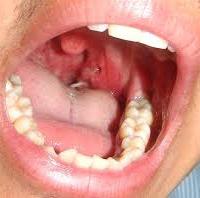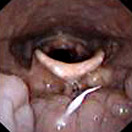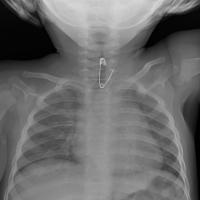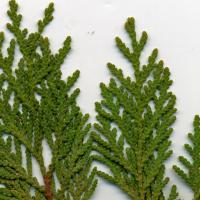Oropharynx (Tonsils)
Fishbones are common foreign bodies. Usually a fishbone lodged in a tonsil can be removed without general anaesthesia.
When an object lodges in the swallowing passage, the victim gags, retches and may vomit.
The victim might have a mild “throat-clearing” cough, but not a violent coughing fit.
Throat pain is felt with each swallow. This pain may radiate to the ear(s).

Fishbones are common foreign bodies. Usually a fishbone lodged in a tonsil can be removed without general anaesthesia.

This fishbone is lodged in the base of the tongue, just above the epiglottis (and the rest of the larynx). Sometimes fishbones become lodged a piriform sinus (to the side of the larynx) or in the esophagus. The lower the fishbone, the more likely general anaesthesia will be needed to remove it.[Ref:48]

Coins and fishbones are the most common esophageal foreign bodies, but disc batteries and safety pins are more dangerous. Other examples include buttons, hair clips, paper clips and large pieces of meat. Large esophageal foreign bodies may compress the trachea from behind (causing airway obstruction).

Foreign bodies rarely are propelled up from the throat and behind the soft palate. Cedar twigs are the most common nasopharyngeal foreign body in the Pacific Northwest. The rubber propeller from a Kinder Surprise airplane has also been removed from a toddler’s nasopharynx.
In a 2011, a US National Safety Council report stated that choking caused 4,500 deaths (amongst all ages) in the United States in 2009.[Ref:46]